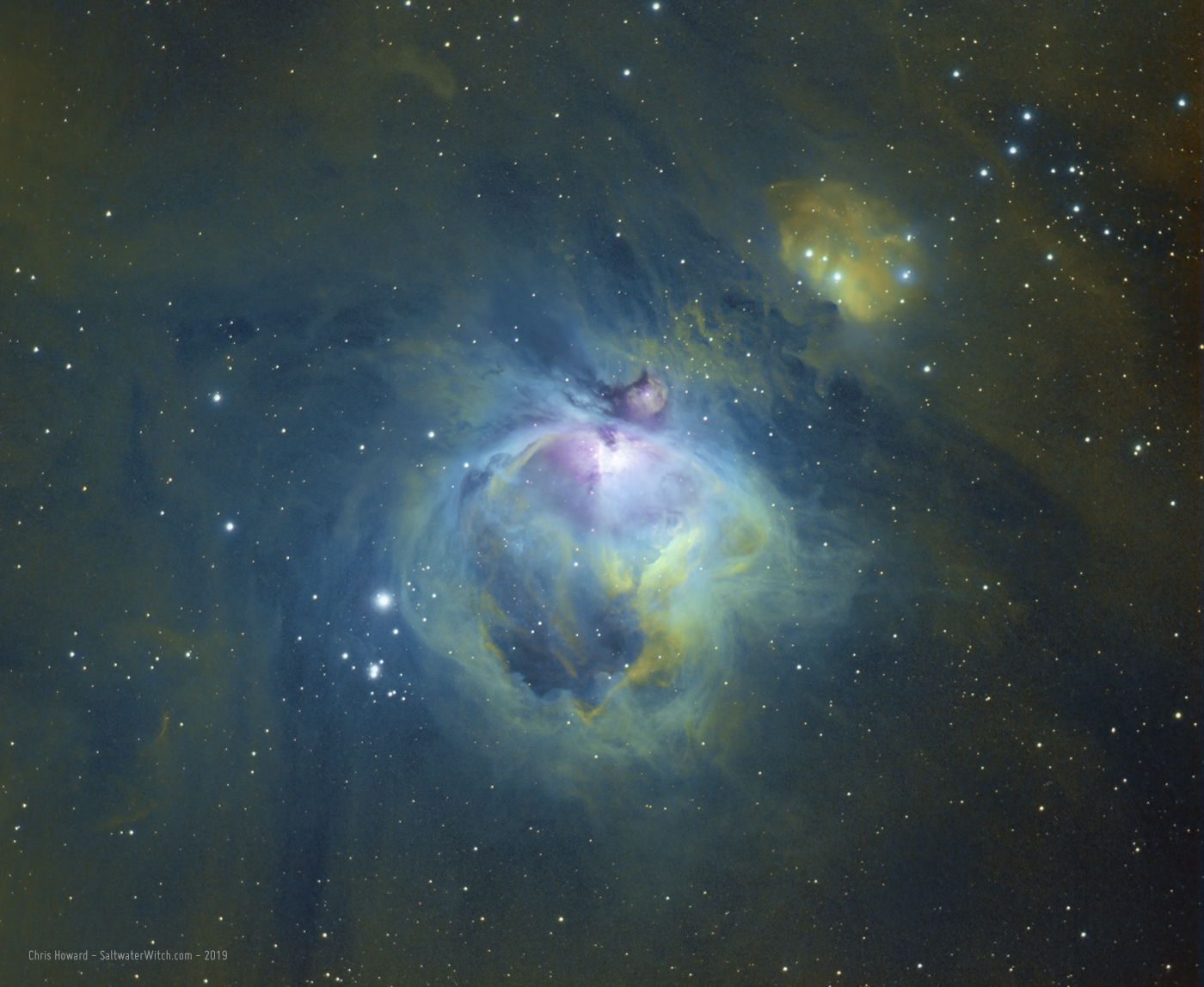Orion Nebula (M42) in the SHO Hubble Palette
September 29, 2019
I have been thinking about how to represent false-color imaging for deep sky objects, and I've been keeping more of that abundant hydrogen green in the mix when doing SHO Hubble Palette images, where we map Sulfur, Hydrogen, and Oxygen bandpasses to Red Green Blue (RGB). Because hydrogen is--by a wide margin--the most abundant element in the universe, and many of these nebulae are HII Regions (vast expanses of interstellar ionized hydrogen), there ought to be more green in SHO images than we normally see. It's become standard to go heavy on a rust red and deep blue, with most of the green removed. All of these color choices are esthetic choices. The images I'm posting come from the data from three separate filters, Ha, OIII, and SII, so in a sense there are no incorrect color levels--within reason.
You do see a lot of color (LRGB) imaging with a target like M42, and with corresponding heavy reds and browns of bandpasses on the red end of the spectrum--and heading off into infrared. Most of my shots of Orion Nebula from past years has been in RGB with a luminance layer.
In the first set I toned the hydrogen green way down--actually all the colors are lower--until I'm just getting a nice green cast over everything.
I expanded on this in an Astrobin comment, dropping it here:
I'm going to reprocess data for some recent targets, see how they turn out. I think the reasoning is sound--that we should see more green with SHO, but we'll have to see how the images look. I know many handle this already by going with HSO to map Ha to Red, which makes a lot of sense, closer to where Ha is on the EM spectrum, even if we put sulfur in Green with this pattern. At the end of the day, though, it's still about how beautiful these images of nebulae look, and how each of us measures that beauty. It could also be that dozens of others have gone through this exact cycle with color levels and patterns and ended up back where we are today, simply because the stronger blues and reds are more appealing! I think one of the best things about this hobby/obsession is that it's data driven, and when I get new data and I try new techniques--and I like what I see, I can go back and reprocess data and try these techniques on other targets. There's something very powerful about this.

M42 Orion Nebula with the stars removed. I used the star removal in Annie's Astro Actions in Photoshop, which gets you 90% there, with some cleanup around the remnants of larger stars. Okay, this looks like H.R. Giger's version of the Orion Nebula.

To show you what I mean by "no incorrect color levels", this is the same imaging data, from the same stacked Ha, OIII, and SII frames. I just went in a different direction with which bandpass to stress--oxygen in this case, with stronger blues. It's strange how the "running man" shape in Sh2-279 Running Man Nebula, the brightish cloud above Orion, only appears faintly in narrowband. And in Orion, on the bottom right side, there's the weird chicken leg of hydrogen that now stands out behind the wispy pale clouds that ring the nebula.

And here's the same data set in HSO, with hydrogen-alpha mapped to red in RGB, sulfur green, and oxygen blue. You could argue that this is slightly more natural, as the hydrogen-alpha line is off the red end of the visible spectrum at 656nm, just this side of infrared. Mapping Ha to red makes sense, but mapping sulfur to green doesn't. The sulfur line is also on the red end of the spectrum, which is why normal RGB images of most deep sky objects taken with a DSLR or OSC camera are usually very red.


Imaging notes: William Optics GT81 at f/4.7 with WO 0.8x Flat6A II, Astronomik Ha, OIII, SII 6nm filters, Moonlite focuser, ZWO ASI120MM OAG, Imaging camera: ZWO ASI1600MM Pro cooled mono on an Orion Atlas EQ-G mount. Stacked in DSS, processed in PS CC 2019. 40 x 120 second exposures for each filter.
